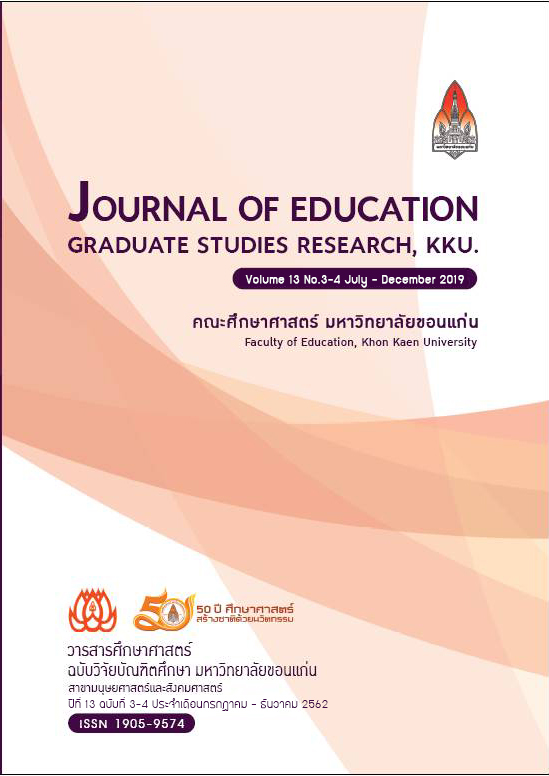The effects of Blended Learning with Collaborative Learning Using Group Investigation Technique to Enhance Science Solving Thinking of Grade VII Students
Main Article Content
Abstract
The proposes of this study were: (1) To plan Blended Learning with Collaborative Learning by using Group Investigation Technique in order to enhance Science Solving Thinking of grade VII students; (2) To compare the ability of Science Solving Thinking of grade VII students before and after providing Blended Learning; (3) To compare learning achievement of grade VII students before and after providing Blended Learning; and (4) To survey satisfaction of learners toward Blended Learning with Collaborative Learning by using Group Investigation Technique in order to enhance Science Solving Thinking. A sample of this research was selected from 32 students of grade VII. This study used simple random sampling method. The tools used in this research: 1) Blended Learning with Collaborative Learning by using Group Investigation Technique in order to enhance Science Solving Thinking of grade VII students; 2) Pre- and Post-Test of Science Solving Thinking consisted of 5 written questions (Difficulty Rate between 0.50 – 0.80, Discrimination Rate between 0.20 – 0.60, and Reliability Rate at 0.94); 3) Achievement Test include of 20 choice questions that Is a multiple choice 4 options (Difficulty Rate between 0.40 – 0.75, Discrimination Rate between 0.20 – 0.80, and Reliability Rate at 0.89); 4) Learners satisfaction survey in Blended Learning with Collaborative Learning by using Group Investigation Technique (IOC=0.7). This’s a Quasi Experimental Research and data are analyzed by using percentage, mean, standard deviation, and t-test
Based on the findings of this investigation, it was concluded that:
- Blended Learning with Collaborative Learning using Group Investigation Technique to enhance Science Solving Thinking of Grade VII students had Efficient Rate at 82.02/81.96
- Posttest scores of Science Solving Thinking were higher than pretest scores and were significant difference at .05
- Posttest scores of Achievement in Blended Learning were higher than pretest and were significant difference at .05
- Learners satisfaction toward Blended Learning with Collaborative Learning by using Group Investigation Technique in order to enhance Science Solving Thinking was at high level.
Article Details
References
ธีระเกียรติ เจริญเศรษฐศิลป์. (2559). การศึกษาไทย 4.0 ในบริบทการจัดการศึกษาเพื่อการพัฒนาที่ยั่งยืน. ค้นเมื่อ 25 ตุลาคม 2560, จากhttp://www.moe.go.th/moe/th/news/detail.php?NewsID=46211&Key=news _Teerakiat
ประยุทธ์ จันทร์โอชา. (2559). ไขรหัส “ประเทศไทย 4.0” สร้างเศรษฐกิจใหม่ ก้าวข้ามกับดักรายได้ปานกลาง. ค้นเมื่อ 16 ตุลาคม 2560, จาก https://www.thairath.co.th/content/613903
พิเชฐ ดุรงคเวโรจน์. (2559). บทบาทของมหาวิทยาลัยไทยต่อ Thailand 4.0. ค้นเมื่อ 16 ตุลาคม 2560,จาก https://www.facebook.com/MinisterPichet/posts
ไพรินทร์ ศรีสินทร. (2561). ผลของการประยุกต์ใช้วิธีการเรียนรู้แบบร่วมมือในการจัดกาเรียนการสอนภาษาจีน ในฐานะภาษาต่างประเทศ:กรณีศึกษาวิชาไวยากรณ์ภาษาจีน. วารสารศึกษาศาสตร์ มหาวิทยาลัยขอนแก่น, 41(4), 54-59
วิจารณ์ พาณิช. (2555). วิถีสร้างการเรียนรู้เพื่อศิษย์ในศตวรรษที่ 21. กรุงเทพฯ: ตถาพับลิเคชั่น.
ศรัณยา อินทรภิรมย์. (2556). ผลการจัดกิจกรรมการเรียนรู้แบบผสมผสานระหว่างห้องเรียนปกติและบนเครือข่ายสังคมโดยใช้การเรียนรู้แบบร่วมมือเทคนิค TGT เรื่อง ระบบการจัดเก็บทรัพยากรสารสนเทศ. วิทยานิพนธ์ปริญญาครุสาสตรอุตสาหกรรมมหาบัณฑิต สาขาวิชาเทคโนโลยีการเรียนรู้และสื่อสารมวลชน บัณฑิตวิทยาลัย มหาวิทยาลัยเทคโนโลยีพระจอมเกล้าธนบุรี.
สุวัฒน์ นิยมไทย.(2553). การพัฒนารูปแบบการเรียนการสอนวิชาชีพแบบผสมผสาน โดยใช้โครงงานเป็นฐานในสถานประกอบการเพื่อพัฒนาการปฏิบัติงานและการแก้ปัญหาสำหรัยนักเรียนระดับประกาศนียบัตรวิชาชีพช่างอุตสาหกรรม. กรุงเทพฯ :จุฬาลงกรณ์มหาวิทยาลัย.
Ahlfeldt, S. L. (2004). Problem-Based Learning in The Public Speaking Classroom. Retrieved August 26, 2006, from http://dcms.thailis.or.th/cgibin/websis?show= 002495&from=ebook
Ausburn, L. J. (2004). Design components most valued by adult learners in blended online education environments: An American perspective. Educational Media International, 41(4), 327-337.
Garrison, D. R., & Vaughan, N. (2008). Blended Learning in Higher Education: Framework, Principles, and Guidelines. Retrieved March 2, 2017, from https://coi.athabascau.ca/books/book-blended-learning-in-higher-education/
Graham, C. R. (2012). Emerging practice and research in blended learning. In M.G. Moore (Ed.). Handbook of distance education. 3rded. (pp. 333–350). New York: Routledge.
Glenna, K. D. (2006). Proportional Process Conflict In Undergraduate Cooperative Learning Groups. [n. p.]: Liberty University.
Horn, M., & Staker, H. (2011). A case study of blended teaching and learning in a New Zealand secondary school, using an ecological framework. Pinelopi Zaka: University of Canterbury
Johnson, D. W. (1999). Cooperative Learning and Competition. [n. p.]: Minn Interaction Book.
Joyce, B., & Weil, M. (1992). Models of Teaching. 3rded. Englewood Cliffs, N.J.:Prentice- Hall.
Khan, B. H. (1997). Web-based instruction. New Jersey: Educational Technology Publications.
Rothmund, A. C. (2008). Correlation between Course Interactive and Reported Levels of Student Satisfaction in Hybrid Courses. Texas: University of North Texas.

